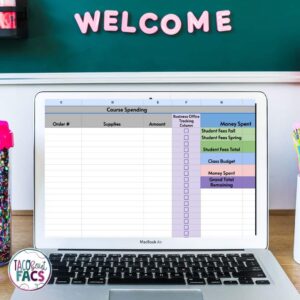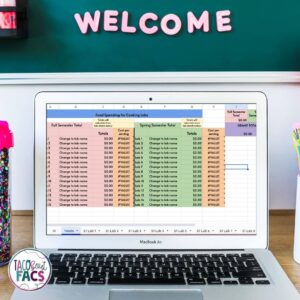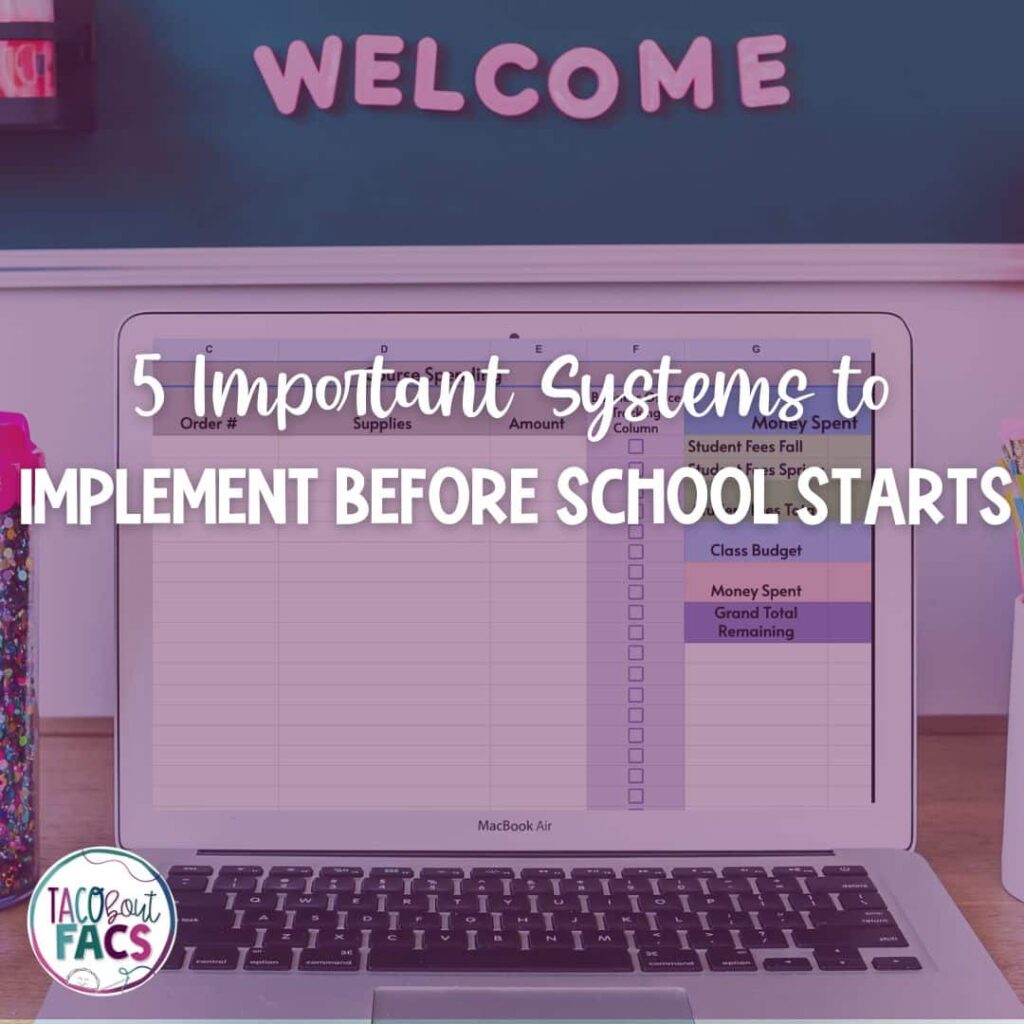Setting up essential classroom systems before school starts is yet another way to make sure you’re setting yourself, and your students, up for success.
Family and Consumer Sciences classrooms usually have multiple preps, loads of supplies and activities. The more time spent behind the scenes creating a framework, the better.
Here are 3 essential classroom systems to implement before school starts without feeling overhwelmed.
Classroom budget
Spending, spending, and more spending. It’s a great thing, but it can be a tedious task to track. Classroom spending at this level requires a strong system.
Even if you have the most amazing and meticulous secretary to track your spending, like I do, you likely still have quite a bit of spending to track.
Between collecting student fees, a classroom budget, countless Amazon, Walmart, and other online orders, I needed a simple, yet detailed way to organize my spending.

How does it work?
This editable spreadsheet is approved by the secretary in charge of my budget. I share a new Spreadsheet with her each year. I add my orders and order number. She has a checkbox to mark when the purchase clears.
The Spreadsheet is also set up to add together student fees and a classroom budget, as well as subtract any expenses. I can quickly and easily see my remaining budget.
If this sounds like something you could use, grab it for free.
Cooking lab cost-per-serving
Another part of my spending that I like to pay close attention to is cost-per-serving.
This isn’t a system I regularly track when I repeat recipes. However, I do like to switch things up each semester. When I implement a new recipe, I use this tracker to track recipe spending and cost-per-serving.
I want to be able to justify spending and this is an easy way to plug in the amount spent and the Spreadsheet will auto-calculate the little details.

You can also grab the tracker for free here.
Routines and procedures
This is where former elementary teachers use their strength, but it’s easy enough for anyone. Determine your top priorities routines and procedures to teach during the first couple weeks of school.
Plan it out in your head or write it out to wrap your mind around it. Be specific! What will it look like and what will it sound like?
For example, my students cannot enter the room until they are invited. This allows the previous hour to exit the room first. It gives me a chance to quickly use the restroom if needed or 20 seconds of peace to make sure the Daily Slide is back on the screen and I can take a breath.
Another routine is for students to be seated before the bell rings at the end of class. I have a phone alarm set for 2 minutes before the bell. This gives students a chance to put things away and clean up, but they must be seated before the bell rings. Otherwise they will be the last to leave. It only takes once or twice to learn the hard way.
I teach routines and procedures with Taylor Swift lyrics and my bitmoji. it’s cheesy and fun, but I teach 7th and 8th graders who are also cheesy and fun. We cover routines and procedures throughout the first week and I will continue to discuss them until students meet those expectations.
First week of school fun
Another way I prepare before school starts is filling the first week with fun and strategic lessons. I make sure everything is ready and then pick and choose the activities based on the day and energy level.
We cover a lot of things, but keep the class light and engaging. My district starts on a Monday, which means by Friday, we are dragggggging.
I need as much pep and excitement as my students.
I still cover the syllabus, my expectations, teach routines and procedures, but with fun activities mixed in between.
There is plenty to teach and not enough time, but it’s far easier to spend time focusing on the basics before moving on to curriculum. Also because incoming 7th graders are introduced to junior high. It’s more productive to cover expectations slowly than to dive right into curriculum.
You can find the exact first week activities I use here.
I will also make it a point to get all first week copies made before the first day of school. I want to make sure my first week is the least amount of stress possible. Visiting the copy machine, waiting in line, and fixing a paper jam usually aren’t on my agenda.
Setting yourself up for success is preparing behind the scenes before school starts.
The more prepared you can be ahead of time will alleviate the stress and headache that will come when you’re scrambling to get your ducks in a row.
Don’t forget to download the budget tracking spreadsheets to keep your spending in check!


